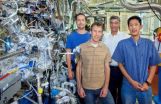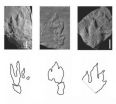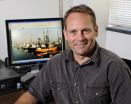(Press-News.org) Measuring a fuel cell's overall performance is relatively easy, but measuring its components individually as they work together is a challenge. That's because one of the best experimental techniques for investigating the details of an electrochemical device while it's operating is x-ray photoelectron spectroscopy (XPS). Traditional XPS works only in a vacuum, while fuel cells need gases under pressure to function.
Now a team of scientists from the University of Maryland, the U.S. Department of Energy's Sandia National Laboratories, and DOE's Lawrence Berkeley National Laboratory has used a new kind of XPS, called ambient-pressure XPS (APXPS), to examine every feature of a working solid oxide electrochemical cell. The tests were made while the sample cell operated in an atmosphere of hydrogen and water vapor at one millibar pressure (about one-thousandth atmospheric pressure) and at very high temperatures, up to 750° Celsius (1,382 degrees Fahrenheit).
"Our team, led by Bryan Eichhorn of the Department of Chemistry and Biochemistry at the University of Maryland, combined the expertise in fuel cells at U Maryland, the experience of our Sandia Lab colleagues in collecting electrochemical data, and Berkeley Lab's own development of a method for doing x-ray photoelectron spectroscopy in situ," says Zahid Hussain of Berkeley Lab's Advanced Light Source (ALS). "Together we were able to measure the fundamental properties of a solid oxide fuel cell under realistic operating conditions."
The researchers report their results in the November, 2010 issue of Nature Materials, in an article now available to subscribers in advance online publication at http://www.nature.com/nmat/journal/vaop/ncurrent/full/nmat2851.html.
How a solid oxide fuel cell works
Like a battery, a fuel cell is a device that uses chemical reactions to produce electricity. Unlike a battery, a fuel cell won't run down as long as it's supplied with fuel and oxidant from outside. The main components are two electrodes, an anode and a cathode, separated by an electrolyte.
In a solid oxide cell (SOC) the cycle begins at the cathode, which ionizes oxygen (usually from air) by adding free electrons. These oxygen ions then flow through the solid oxide electrolyte (from which the SOC gets its name), often a material known as yttria-stabilized zirconia. High temperature is needed to maintain good conduction of oxygen ions through the electrolyte.
The oxygen ions travel through the electrolyte to reach the anode, where they oxidize the fuel. (The fuel may be pure hydrogen gas or a hydrocarbon.) Electrons freed by oxidation form the current in the device's electrical circuit and eventually return to the cathode. Unused fuel or other compounds, plus water formed from the positive hydrogen ions and negative oxygen ions, exits the fuel cell.
For the APXPS experiment, the University of Maryland collaborators built a model fuel cell that combined the essential elements of an SOC in a special miniaturized design less than two millimeters in length. Except for the electrolyte of yttria-stabilized zirconia, which formed the base of the device, the various components were thin films measuring from 30 nanometers (billionths of a meter) up to 300 nanometers thick.
Says the University of Maryland's Eichhorn, "We designed and fabricated solid oxide electrochemical cells that provided precise dimensional control of all the components, while providing full optical access to the entire cell from anode to cathode."
Instead of stacking the components as in a real fuel cell, the sample's arrangement was a planar design that placed all the components on the same side of the electrolyte, so the x-ray beam from the ALS could reach them. This allowed direct measurement of local chemical states and electric potentials at surfaces and interfaces during the cell's operation.
Introducing ambient-pressure x-ray photoelectron spectroscopy
Photoemission occurs when light ejects electrons from a material. By collecting the emitted electrons and analyzing their energies and trajectories, photoelectron spectroscopy establishes exactly what elements are in the material and their chemical and electronic states within narrow regions. At the Advanced Light Source, intense x-ray light is used to explore what happens at or near the surface of materials: the only photoelectrons that can escape are from atoms near the surface.
The APXPS system begins by shining the x-ray beam on the sample fuel cell inside a chamber at the ambient pressure of the gas needed for it to operate. The emitted electrons then travel through chambers pumped to lower pressure, finally entering the high-vacuum chamber of the detector. By itself this arrangement would lose emitted electrons at every stage because of their spreading trajectories, leaving a signal too weak to be useful. So Berkeley Lab researchers developed a system of "lenses" – not made of glass but of electric fields – to capture and refocus the emitted electrons at each stage, preventing excessive loss.
"This is what allows us to find out what's happening within small regions on the surface of a sample in the presence of a gas," says Hendrik Bluhm of Berkeley Lab's Chemical Sciences Division, one of the inventors of APXPS, which was awarded a coveted R&D 100 Award in 2010. "Using the APXPS instruments at the ALS's molecular environmental science beamline, 11.0.2., and the chemical and materials science beamline, 9.3.2, we can spatially correlate the catalytic activity with the electrical electrical potentials across the different components of the model fuel cells."
Says Zhi Liu of the ALS, "At first we weren't sure we could use this technique with an operating fuel cell, because we had to bring it to 750° C—an extreme temperature for such ambient pressure experiments. Few people have done it before. Now we're able to perform this kind of analysis routinely."
Michael Grass of the ALS says, "What you need to know to improve any kind of fuel cell is where the inefficiencies are—places where energy is being lost compared to what theoretically should be possible. By scanning across the surface of the cell while it was operating, we could directly measure both the inefficiencies and the chemical states associated with them."
A new way to study electrochemistry in action
With their model SOC, the Maryland-Sandia-Berkeley Lab team saw details never seen before in an operating fuel cell. Where an overall measurement gave only the fuel cell's total losses in potential energy, the APXPS measurements found the local potential losses associated with the interfaces of electrode and electrolyte, as well as with charge transport within the ceria electrode. The sum of the losses was equal to the cell's total loss, or inefficiency.
"The in situ XPS experiments at 750 C allowed us to pinpoint the electroactive regions, measure length scales of electron transport through mixed ionic-electronic conductors, and map out potential losses across the entire cell," Eichhorn says. "Others have suggested similar experiments in the past, but it was the remarkable facilities and scientific expertise at the ALS that facilitated these challenging measurements for the first time."
APXPS can provide this kind of fundamental information to solid oxide fuel cell designers, information not available using any other technique. New fuel cell designs are already taking advantage of this new way to study fuel cells in operation.
INFORMATION:
"Measuring fundamental properties in operating solid oxide electrochemical cells by using in situ x-ray photoelectron spectroscopy," by Chunjuan Zhang, Michael Grass, Anthony McDaniel, Steven DeCaluwe, Farid El Gabaly, Zhi Liu, Kevin McCarty, Roger Farrow, Mark Linne, Zahid Hussain, Gregory Jackson, Hendrik Bluhm, and Bryan Eichhorn, appears in the November, 2010 issue of Nature Materials and is available to subscribers in advance online publication at http://www.nature.com/nmat/journal/vaop/ncurrent/full/nmat2851.html. Zhang, DeCaluwe, Jackson, and Eichhorn are with the University of Maryland. McDaniel, Gabaly, McCarty, Farrow, and Linne are with Sandia National Laboratories. Grass, Liu, Hussain, and Bluhm are with Berkeley Lab.
Berkeley Lab is a U.S. Department of Energy national laboratory located in Berkeley, California. It conducts unclassified scientific research for DOE's Office of Science and is managed by the University of California. Visit our website at http://www.lbl.gov.
Fuel cells in operation: A closer look
2010-10-06
ELSE PRESS RELEASES FROM THIS DATE:
Neuroscience research may help patients recover from brain injury
2010-10-06
New neuroscience research by life scientists from UCLA and Australia may potentially help people who have lost their ability to remember due to brain injury or disease.
By examining how we learn and store memories, these scientists have shown that the way the brain first captures and encodes a situation or event is quite different from how it processes subsequent similar events.
The study is published in the Sept. 29 edition of the online journal PLoS ONE, a publication of the Public Library of Science.
Memories are formed in the part of the brain known as the ...
AGU journal highlights -- Oct. 5, 2010
2010-10-06
The following highlights summarize research papers that have been recently published in Geophysical Research Letters (GRL), Journal of Geophysical Research-Atmospheres (JGR-D), or Water Resources Research (WRR).
1. Antarctic sea ice increase not linked to ozone hole
While sea ice extent has declined dramatically in the Arctic in recent years, it has increased slightly in the Antarctic. Some scientists have suggested that increased Antarctic sea ice extent can be explained by the ozone hole over Antarctica. Previous simulations have indicated that the ozone hole induces ...
Oldest evidence of dinosaurs found in Polish footprints
2010-10-06
The oldest evidence of the dinosaur lineage—fossilized tracks—is described this week in Proceedings of the Royal Society B. Just one or two million years after the massive Permian-Triassic extinction, an animal smaller than a house cat walked across fine mud in what is now Poland. This fossilized trackway places the very closest relatives of dinosaurs on Earth about 250 million years ago—5 to 9 million years earlier than previously described fossilized skeletal material has indicated. The paper also described the 246-million-year-old Sphingopus footprints, the oldest evidence ...
Study: Small firms need more access to credit during financial troubles
2010-10-06
CHAMPAIGN, Ill. – When the economy sours, small firms seeking credit tend to face higher costs of financing, leading them to reinvest their profits before they pay off creditors, according to research published by a University of Illinois finance expert.
Small firms, especially those considered financially constrained as a result of their size, low dividend payment or lack of bond rating, often become bogged down in debt because they "get hooked on cheap money, when they can find it" says U. of I. finance professor Murillo Campello.
"Since small firms are usually financially ...
New fisheries system will save about $20 million, Iowa State University researchers find
2010-10-06
AMES, Iowa - Some fisheries in the United States are poised to undergo major changes in the regulations used to protect fish stocks, and Iowa State University researchers have estimated that the new system will be an economic boon to the fishing industry.
Quinn Weninger and Rajesh Singh, both associate professors in economics, estimated harvesting costs under the old system and compared that to the newly proposed fishing regulations that lift many restrictions that cause inefficiency while still limiting amounts to be harvested.
Their analysis focused on the Pacific Groundfish ...
Animations show extent of marcellus shale development
2010-10-06
The pace and extent of Marcellus Shale development across Pennsylvania can be "seen" in animated maps produced by the Penn State Marcellus Center for Outreach and Research.
Based on data from the Pennsylvania Department of Environmental Protection, the animations (http://www.marcellus.psu.edu/resources/maps.php) show both the number of drilling permits issued for the Marcellus Shale target and the number of wells drilled by year from 2007 through August 2010. Although permits were issued prior to 2007, information on those permits did not include latitude and longitude.
"These ...
A thirst for excitement is hidden in your genes
2010-10-06
Sensation seeking—the urge to do exciting things—has been linked to dopamine, a chemical that carries messages in your brain. For a new study published in Psychological Science, a journal of the Association for Psychological Science, scientists analyzed genes in the dopamine system and found a group of mutations that help predict whether someone is inclined toward sensation seeking.
Sensation seeking has been linked to a range of behavior disorders, such as drug addiction. It isn't all bad, though. "Not everyone who's high on sensation seeking becomes a drug addict. They ...
UNH researcher helps identify key reproductive hormone in oldest vertebrate
2010-10-06
DURHAM, N.H. -- Looking at a hagfish – an eyeless, snot-covered, worm-like scavenger of the deep –the last thing that comes to mind is sex. Yet the reproductive functioning of these ancient vertebrates is such an enduring enigma that a gold medal was once offered to anyone who could elucidate it.
Although the prize expired, unclaimed, long ago, University of New Hampshire professor of biochemistry Stacia Sower and colleagues at two Japanese universities have identified the first reproductive hormone of the hagfish – a gonadatropin -- representing a significant step toward ...
Early lung cancer detection
2010-10-06
Researchers from Northwestern University and NorthShore University HealthSystem (NorthShore) have developed a method to detect early signs of lung cancer by examining cheek cells in humans using pioneering biophotonics technology.
"By examining the lining of the cheek with this optical technology, we have the potential to prescreen patients at high risk for lung cancer, such as those who smoke, and identify the individuals who would likely benefit from more invasive and expensive tests versus those who don't need additional tests," said Hemant K. Roy, M.D., director ...
Air pollution alters immune function, worsens asthma symptoms
2010-10-06
Berkeley – Exposure to dirty air is linked to decreased function of a gene that appears to increase the severity of asthma in children, according to a joint study by researchers at Stanford University and the University of California, Berkeley.
While air pollution is known to be a source of immediate inflammation, this new study provides one of the first pieces of direct evidence that explains how some ambient air pollutants could have long-term effects.
The findings, published in the October 2010 issue of the Journal of Allergy and Clinical Immunology, come from ...



